Lucien Lelong: Parisian Fashion Pioneer Who Bridged Couture, Cinema, and Ocean Travel Elegance
📌 Explore the life and designs of Lucien Lelong, the Paris couturier whose kinetic silhouettes shaped 20th-century fashion. From ocean liners to Hollywood, his legacy lives on in wearable art, management innovation, and transatlantic style.

Plate 20. Mr. Lucien Lelong, Representative of Modern Business Spirit in Paris Dressmaking Industry. (Economics of Fashion, 1928) | GGA Image ID # 225b99e6d9
✨ Review & Summary: The Legacy of Lucien Lelong – Where Modern Elegance Meets Historical Insight
Lucien Lelong, a towering figure in early 20th-century Parisian couture, emerges from this rich GG Archives collection not merely as a designer of gowns, but as a visionary whose style, management, and philosophy shaped the future of fashion. His relevance stretches beyond the runway—into ocean travel, American consumer culture, and women’s evolving roles in society 🌍🧳👗.
For educators, students, genealogists, and historians, this article is a fashion time capsule, providing an in-depth look at the evolution of modern elegance. With ties to Hollywood stars, innovations in fashion business practices, and iconic textile developments, Lelong’s story is perfect for research, essays, and educational projects alike 📝📖.
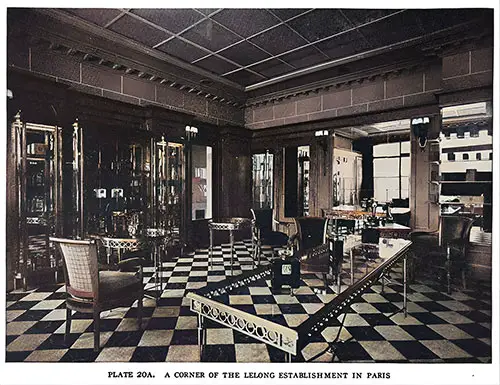
Plate 20A: A Coner of the House of Lelong Establishment in Paris. (Economics of Fashion, 1928) | GGA Image ID # 225b9c439d
Introduction: The House of Lucien Lelong
(History of the House of Lucien Lelong)
Lucien Lelong is perhaps the best representative of the modern business spirit in Paris couture. Lelong is a very wide-awake businessman and an artist. He is a graduate of Oxford University, and although physically not a large man, he is an athlete and an accomplished man of the world.
In his shop, Lelong has introduced the best practices of modern scientific management, including the efficient use of power, the organization and division of labor, proper lighting, provisions for employee safety, and even time and motion studies.
Unlike most of the other leading Paris houses, Lelong's business does not depend upon the genius of one designer. Lelong employs several, and neither one of these designers dominates. What is to be presented at any opening results from a consensus of taste rather than the final word of some individual.
The dress from this establishment is wearable and modern but never sensational. For several seasons, Lelong promoted the "kinetic silhouette," garments made with a view to pleasing appearance while the wearer is in motion.
His chief lines are sports, afternoon, and evening dresses. In company with several other couturiers, Lelong conducts a large accessory business, including perfumes.
Lelong's institution is one of the largest in Paris. It is one of the few Paris skyscrapers, nine stories high. He produces more than a thousand models annually and caters to buyers and manufacturers for quantity production. Lelong's house is one of the most popular for visiting buyers from America.
Lelong's institution has paid great attention to proper presentation when selling its product. All models are shown on a specially prepared stage and always under artificial light.
A lighting system very closely approximates daylighting for sports and outdoor garments. Still, the typical effect of artificial lights is provided for evening wear. This lighting system has been worked out to show the garment to its full advantage.
Monsieur Lelong's creative journey is enriched by his collaboration with the well-known artist and designer Soulié, one of his most precious aides. This partnership has been instrumental in the house's success, as evidenced by the fact that under his management, his firm has more than doubled its buyers' list.
Lelong's signature style is the straight silhouette, a design choice that is both sleek and non-constricting. For the afternoon, he adorns himself with detached panels and tunics, a forecast of the upcoming trend of plain tailor-made designs.
I noticed an excellent black felted satin model, the seams and front underlined by a tiny bright braid. The oversized straight sleeves stand out at right angles from the waist, giving an ample note to the otherwise flat outline.
Among other interesting numbers were magnificent evening coats, good capes, and vague kimono sleeves. One black and silver brocade model had huge, plain, silver lamé sleeves and a Kolinsky collar—a clever combination of color and material.
The use of bright colors on the various stuff for afternoon gowns adds a most attractive note to the otherwise somewhat subdued tone of the most favored fabrics.
Signature Styles and Design Philosophy
Interesting Lucien Lelong Collection
American Tastes Covered by Graceful Lines, Compose Suits, and Fabric Charm.
SILHOUETTE: Immerse yourself in the elegance of the suit, a timeless fashion staple. The long close sleeves, a departure from the medieval square lines, create a refined silhouette that has been a popular choice among fashion-forward individuals.
Embroidered sleeves with tinsel accents, as showcased in America by Helen Mack, add a touch of glamour, reflecting the current trend of incorporating metallic elements into fashion. Draped evening effects beautifully define the figure, a technique that has been used in high-end fashion for its flattering effect.
Soft line garden party frocks, with their loose, low blouse and indefinite lines, exude a relaxed yet sophisticated charm, a style that is perfect for summer events. Full capes, mounted upon straight collars and hanging behind the shoulders, complete the ensemble, adding a dramatic flair to the overall look.
FABRICS: Explore the variety of Rodier fabrics featured. Experience the revival of fine serge. Delight in the touch of Moroccan crepe. Appreciate the elegance of favored foulards. Admire the sheen of blistered satin cire. Revel in the beauty of tinted laces. Enjoy the softness of pastel transparencies. Pastel transparencies. Marvel at the iridescence of changeant taffetas.
DETAILS: Discover the interesting use of pin tucks. Appreciate the intricacy of Venetian cut work. Notice the subtle metallic highlights. Admire the new embroidered effects. Learn about the favored colors-beige, toast, and nut browns. Observe the prominence of high collars.
Business Innovation in Paris Couture
Paris Creators of Apparel Style: Lucien Lelong
Lucien Lelong is a true embodiment of the modern business spirit in Paris couture. He is a businessman and an artist in his own right. A graduate of Oxford University, Lelong may not be physically imposing, but he is a force to be reckoned with. His athletic prowess and worldly accomplishments are a testament to his multifaceted talents.
In his shop, Lelong has introduced the best practices of modern scientific management, including the efficient use of power, the organization and division of labor, proper lighting, provisions for employee safety, and even time and motion studies.
His unique approach to fashion design sets Lelong apart from his peers. Unlike most leading Paris houses, Lelong's business does not rely solely on the genius of one designer. He employs several, and no one of these designers dominates. What is presented at any opening, based on a consensus of taste rather than the final word of some individual?
A dress from Lelong's establishment is not just a piece of art but also a practical and modern garment. It is wearable and contemporary but never sensational. For several seasons, Lelong promoted the "kinetic silhouette," garments made with a view to pleasing appearance while the wearer is in motion. His chief lines are in sports, afternoon dresses, and evening wear. Lelong conducts a large accessory business in the company with several other couturiers, including perfumes.
Lelong's institution is one of the largest in Paris. It is one of the few Paris skyscrapers, nine stories high. He produces more than a thousand models annually and caters to buyers and manufacturers for quantity production. Lelong's house is one of the most popular for visiting buyers from America.
Lelong's institution has revolutionized the art of selling fashion. The meticulous attention to proper presentation is a testament to his forward-thinking approach. All models are showcased on a specially prepared stage under artificial light.
A lighting system closely mimics daylighting is used for sports and outdoor garments. At the same time, the typical effect of artificial lights is provided for evening wear. This innovative lighting system is designed to showcase the garment in the best possible light.
Paris Notes
Among the various collections that strongly appeal to American tastes as now current or in the process of formation is that of Lucien Lelong. It stresses not only the overdone "youthful note" but also considers the younger and older matron in skillfully handled groups.
Length of line is the dominant note, achieved by many and varied means. The low blouse is favored, and the low placement of draperies, low-dipping uneven hems, long close sleeves, and long flowing trains all contribute to this determining factor.
The emphasis on suits is a strong interest in the daywear group. In composition effects, these are effectively worked out in contrasted textures and colors.
Plaids and checks are shown with a leaning towards a favorite type in America: fingertip length, with a shawl collar, low notched, and the left side closing.
One-piece frocks accompanied by either a jacket or cape are especially attractive when they use charmingly varied, vivid colors or novel and expressive details.
When accompanied by the cape, this wrap is jauntily worn swinging from the shoulders, revealing the entire frock in front.
Throughout, Rodier fabrics contribute to the interest of this collection. Bianchini novelties also appear, and fabric interest thus allows for the retention of structurally simple lines.
A noticeable departure in this connection is the abandonment of the long exaggerated simplicity that has prevailed for several seasons past. By using novel fabrics, a certain elaboration is attained in spite of the recognized simplicity of line.
The long close sleeve, either cuffed or pointed to the fingertip effects, supersedes the long popular open square model. Its new line is emphasized by a curious gleaming note of metallic luster threads, tiny rings, discs, and other metal bits employed as highlights of semi-barbaric embroideries of the type introduced in the last Helen Mack collection.
Afternoon Dress
In the suave-line supple fabric frocks, the length is achieved by the low-line blouse and by many methods of achieving uneven hemlines.
Beautifully draped foulards present the long sash end, while black and white chiffon and chiffons with matching tinted laces are extraordinary offerings of appeal to Americans as gowns of great practical value for informal Summer wear.
Evening Wear
The group of evening gowns includes the sumptuous gown with matching wrap, an expensive but otherwise highly satisfactory mode.
Lame cloths and lame laces are conspicuously favored, especially with the glow of color moving upon the metallic sheen.
Flounced laces and the hip distension tulles are much developed in this group. Smooth line bodices prevail for the jeune fille to a large degree, above layers of tulle or net, with lame ribbon discs visible upon varying layers.
Notable Photographs and Design Highlights
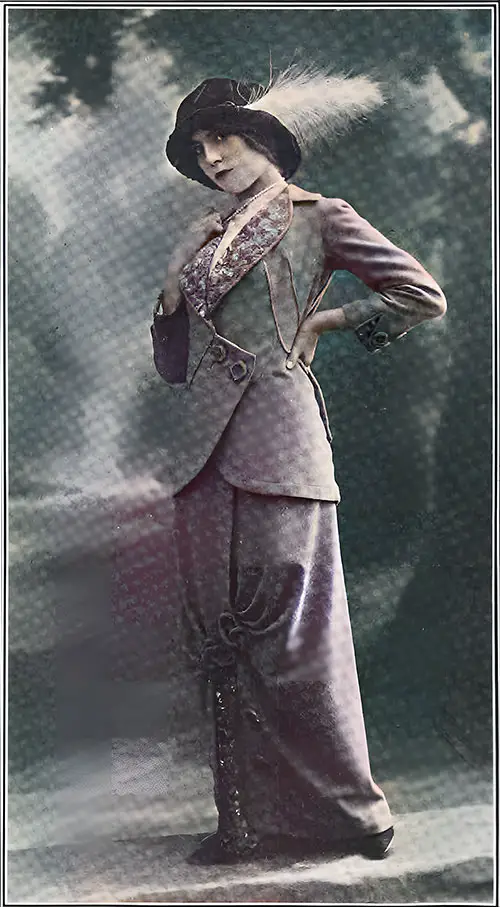
Tailored Costume of Havana Brown Suede Cloth. The Skirt Impiecement and the Coat Revers Are of the Material Heavily Embroidered; the Coat Denotes the Length That Is Popular in Paris. Model from Lelong, Paris. Photo by Talbot. Crerand's Cloak Journal, November 1912. GGA Image ID # 218343ae01
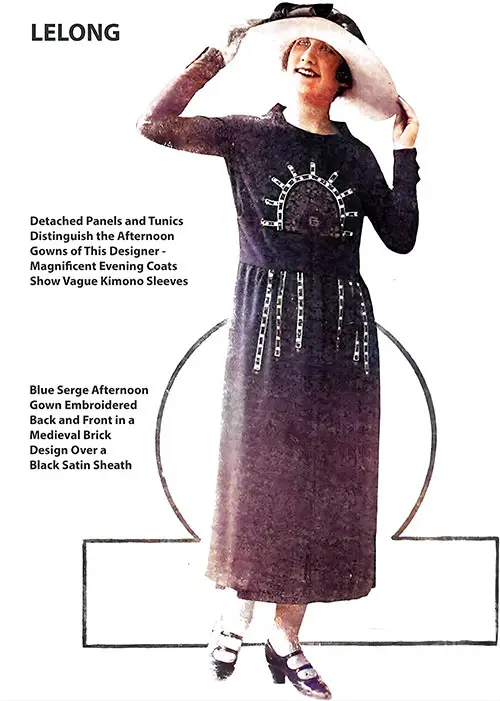
Blue Serge Afternoon Gown Embroidered Back and Front in a Brick Medieval Design Over a Black Satin Sheath. Detached Panels and Tunics Distinguish the Afternoon Gowns of This Designer - Magnificent Evening Coats Show Vague Kimono Sleeves. Garment Manufacturers' Index, October 1920. GGA Image ID # 1a4d9bf827
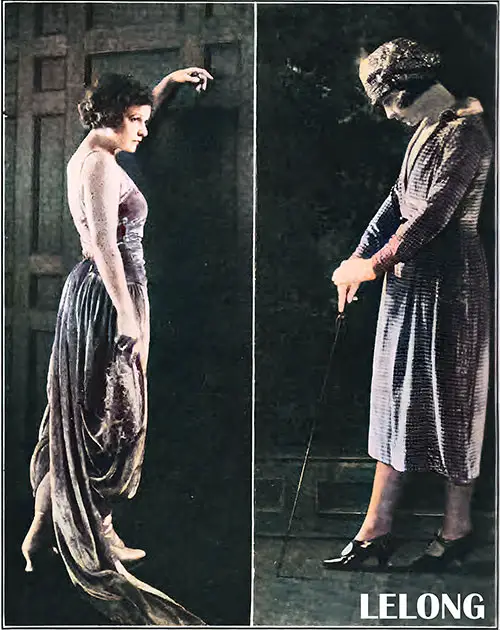
Norma Talmade and Dorothy Gish in Parisian Models from Lucien Lelong. Dresses Magazine, March 1921. GGA Image ID # 21834eed61
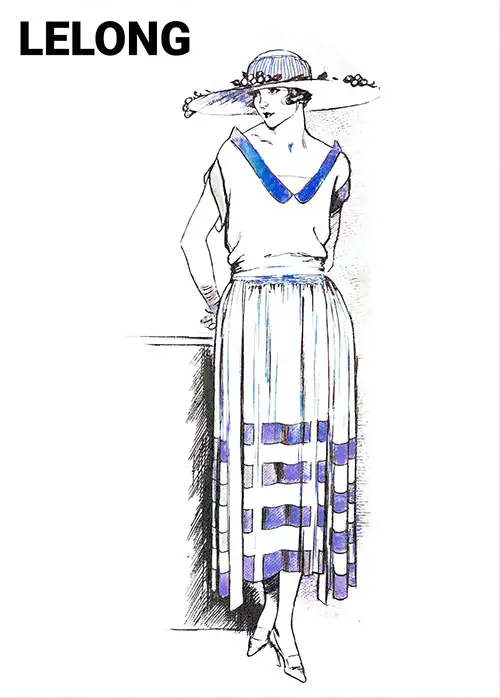
Lucien Lelong's idea of a flared silhouette is showcased in the plaits at either side of an apron tunic. The dress is made of blue-and-white foulard with cherry-silk pipings accentuating the bib line. The Delineator, August 1921. GGA Image ID # 21866c9fdf
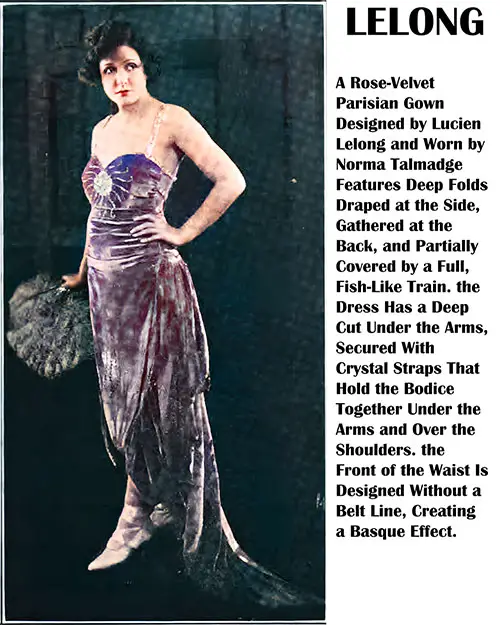
The Parisian Model from Lucien Lelong features Norma Talmadge wearing a dress made of rose velvet. The dress is draped at the side in deep folds, which are caught up in the back and partly covered by a full fish-like train. It has a deep cut under the arms, and the bodice is held together under the arms and over the shoulders by crystal straps. The waist in front is made without a beltline, creating a sort of basque effect. Dresses Magazine, October 1921. GGA Image ID # 2184525bbe
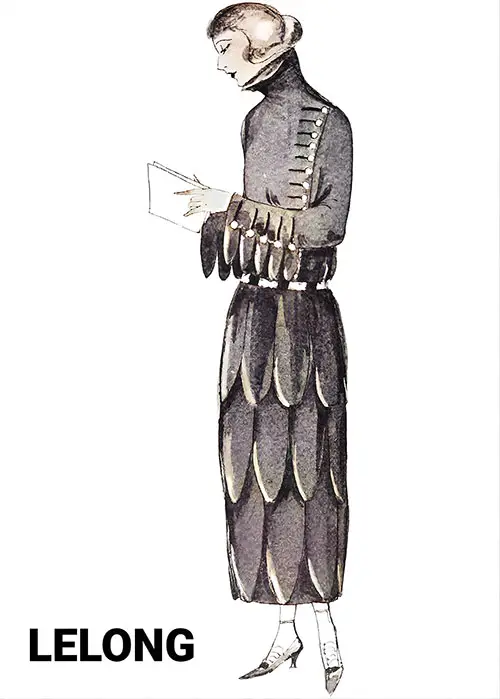
The Newer Petal Mode. Lelong Offers This Unusual Interpretation of the Petal Tab Silk Broadcloth Frock, Which Was Also Shown in Unusual Variations at the Biltmore Pageant de Luxe Flannels and a New Chiffon Velour Are Also Submitted in This Type of Smart Cloth Frock. The American Cloak and Suit Review, March 1922. GGA Image ID # 2182e218e5
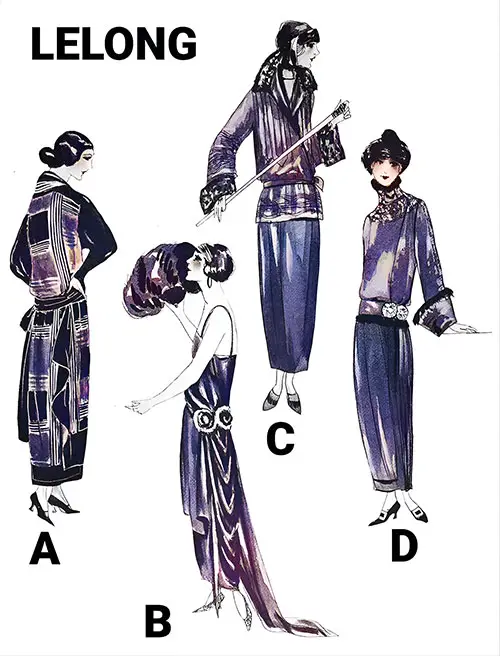
Exclusive Sketches from Lucien Lelong. The American Cloak and Suit Review, July 1922. GGA Image ID # 2182e6fe4e
(A) Plaid velvet, which is the lightest weight, creates this highly effective frock. A new sleeve adds the final touch of smartness.
(B) The frock, with its supple drapery, is a testament to elegance. It's been artfully transposed to the extreme left from the side front of the current season, in a rich black chiffon velvet.
(C) This youthful tailleur, meticulously crafted from high-quality brown leather, features a collar and cuffs made of the increasingly favored leopard skin. It's a showcase of impeccable craftsmanship.
(D) Amazon broadcloth, a highly lustrous version, is expressively interpreted using the green shade formerly known as reseda, a pale yellowish-green color, introducing embroideries and clasps of cloisonne colorings and sable bandings.

A Typical French Frock for the Jenue Fille. Havana Brown Velvet and Finest Serge Present the Combination for this Girlish Model Designed by Lucien Lelong. The American Cloak and Suit Review, July 1922. GGA Image ID # 2182fa8392
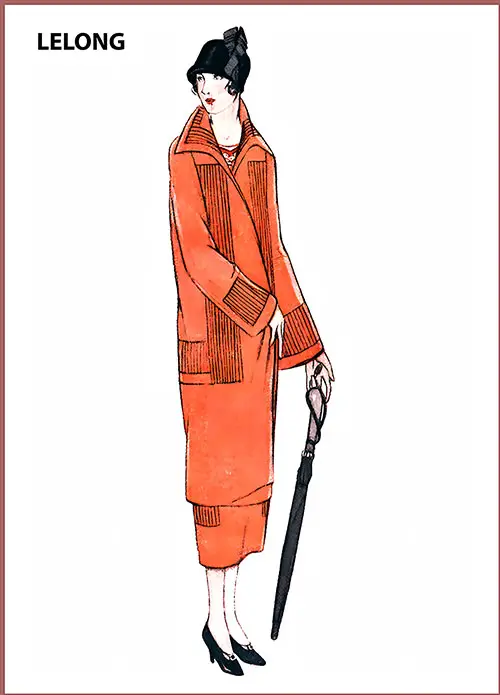
Lucien Lelong Chooses Navy Blue Kasha Cloth and Chinese Print-Silk for an Ensemble Suit. This Versatile Three-quarter-Length Coat Matches Its Plaits With the Plaitings of the Skirt and Its Lining With the Silk of the Dress. Illustration by Helen Thurlow. Woman's Home Companion, September 1924, p. 96. GGA Image ID # 1cd340bd9c
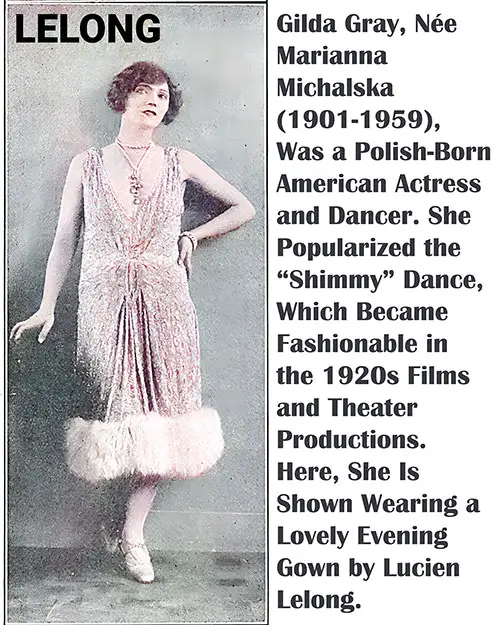
Gilda Gray in an Evening Gown from Lucien Lelong. Dresses Magazine, June 1926. GGA Image ID # 218458f9ab
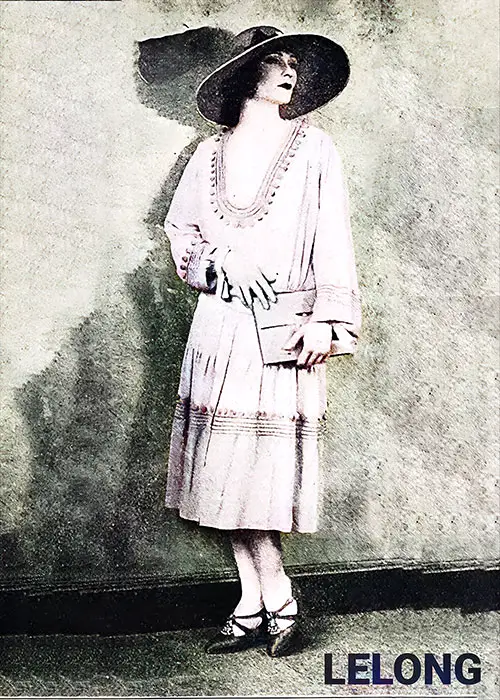
A Gown from Lucien Lelong, Worn by Gilda Gray. Dresses Magazine, July 1926. GGA Image ID # 2184eb5255
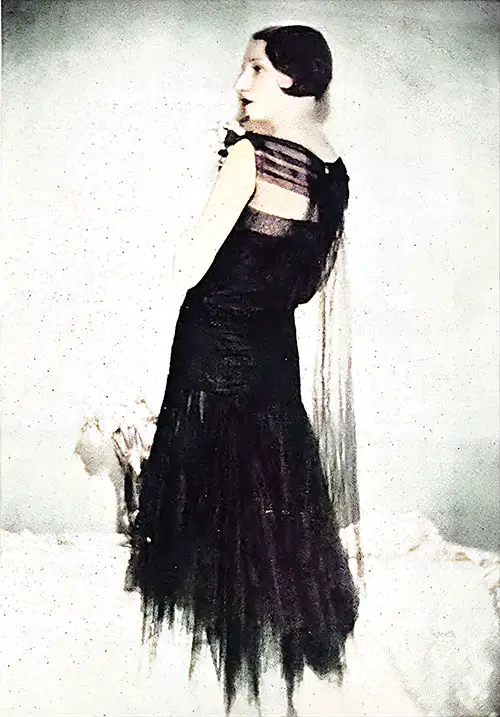
Black Net Evening Gown With Uneven Hemline by Lucien Lelong. Dresses Magazine, June 1928. GGA Image ID # 2184f4b135
Mr. Lucien Lelong's designs are a testament to his meticulous attention to detail. Both models, as illustrated, make a point about the comparison. The understated afternoon gown, crafted in grey, blue, and white faille, features a tiered panel in front and an overlay of pleats on one side. This exquisite model has a ceinture, a narrow, unelaborated cuff, a straight rectangular neck, and a charming repeat design. The Black Net Evening Gown, with its long draping over one shoulder, its wide ceinture and lowered waistline, and the delicate, cascading lace drop of uneven line, is a testament to femininity in its most delicate form.

Afternoon Dress for a Young Girl in Printed Blue, Grey, and White Faille from Lucien Lelong. Dresses Magazine, June 1928. GGA Image ID # 218555a6ae
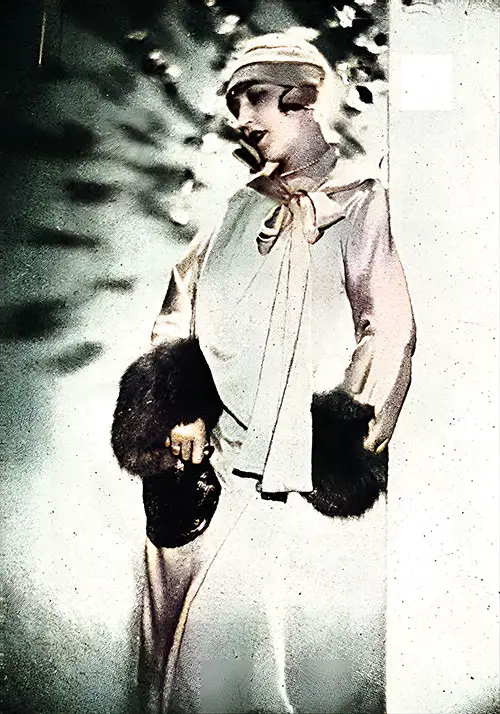
Afternoon Coat of Grey Tiflis Trimmed with Grey Fox from Lucien Lelong. Dresses Magazine, June 1928. GGA Image ID # 218567a67f
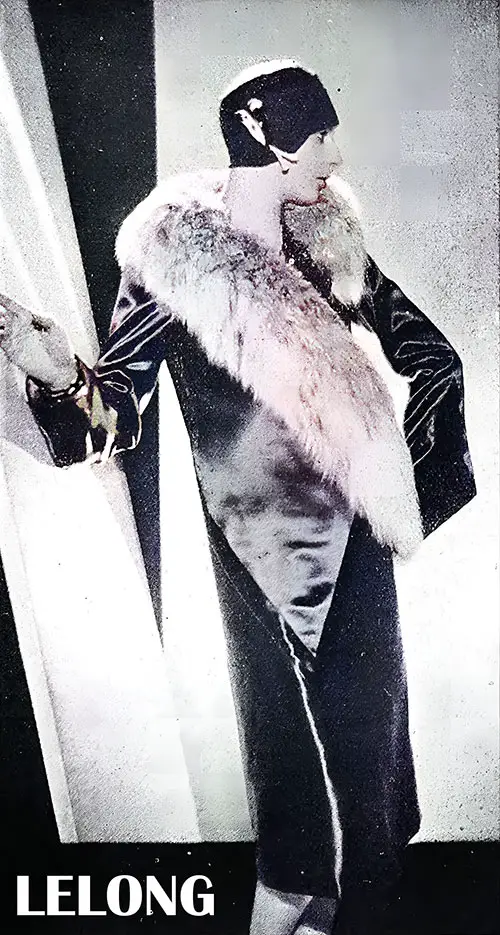
Attenuated Lines Create the Impression of Length and Slimness That Is so Important in the Latest Style Trend: The Coat From Lelong, Which Sponsors Formal Luxury for Fall With Its Use of Blue Satin and Lynx. Dresses Magazine, August 1928. GGA Image ID # 2186397874
The Lelong model in blue satin with lynx, as pictured, conveys the attenuated line of length and slimness. The luxurious use of the lynx and the smart sleeve deserves note. Another Lelong model in the mode of simplicity that young Parisians affect is the pictured afternoon coat trimmed with astrakhan.
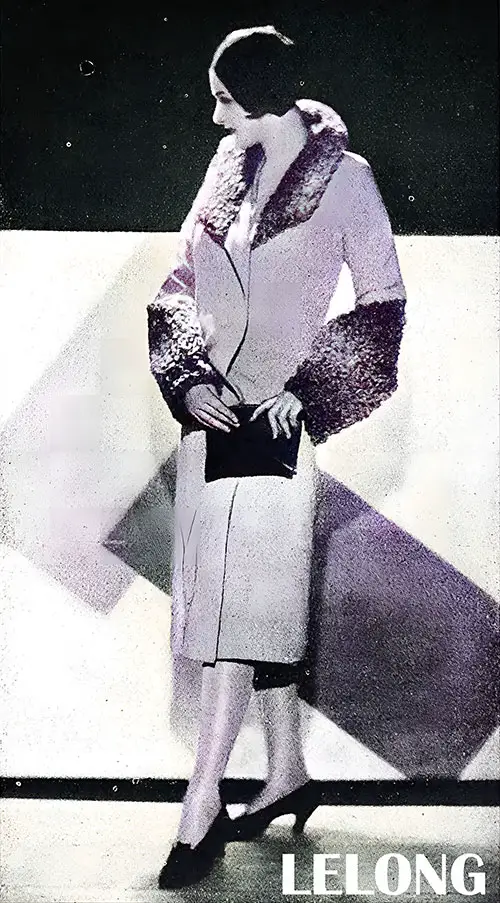
In the Mode of Simplicity Which Young Parisians Affect is This Straight Line Coat from Lelong with Collar and Deep Cuffs of Astrakhan to Sound the Omnipresent Note of Luxury. Dresses Magazine, August 1928. GGA Image ID # 2186041bd3
Famous Clients: From Hollywood to Haute Couture
(With Screen Favorites By Emilie Frances Bauer)
Lillian & Dorothy Gish
If there is one class of stage women who get less pleasure out of their clothes than any other, it is the screen actresses, who, for the most part, are dependent upon orders for what they wear on the stage and during the picture-making time, they work at such a tension that they have little inclination for anything but rest. This was cleverly told by LILLIAN GISH, who, with her sister Dorothy, represents the pet children of the stage.
It may come as a surprise to the thousands, perhaps millions, of friends of the famous movie actress to state that the picture she is shown is the dress in which she married James Rennie. Of course, Miss GISH is one of the patriotic American dressers. However, even in Paris, she couldn't resist the allure of the exquisite style of Lucien Lelong, who is gaining some of the trade formerly held exclusively by those with better-known names.
The gown shown here is not the typical bride gown, but little Miss GISH never does the usual things. The gown is of black and while checked velvet with panels at either side of the skirt lined with silver cloth, and the collar and revers are also of silver cloth. There are fancy crystal buttons on the skirt and shoulders and a little black patent leather belt across the front.
DOROTHY GISH, who is as timid as a child of ten, one might add that she does not look much more, insisted upon being represented verbally by her sister, LILLIAN GISH, who said, "We are not accustomed to speaking with the lips, and we are very timid when it comes to that. Indeed, for years, we have been trained to say all that had to be said by body movements that had, figuratively, to speak louder than words. We say things mostly with the eyes—" and LILLIAN GISH flashed those beautiful eyes that have traveled away from the screen with almost everyone who has ever seen them.
It is well known among those informed that the eyes of LILLIAN GISH have made more "movie fans" than virtually any other features in picture life. One could hardly help being a "fan" of the GISH sisters, particularly after seeing them in the flesh. The interviewer became more interested in how it feels to be a "movie" favorite than what that favorite thought of her wardrobe.
LILLIAN GISH, the spokesman for both, expressed her regret at the number of people who think that all the blood-curdling experiences are "studio" pictures. She spoke of the most incredible thrill she had ever experienced in her life as follows: "For a long time, I thought that life would never bring to me anything greater, anything that would seem like a more awe-full (I don't mean awful, although it was) than the experience we had while entertaining the A. E. F. overseas when a German plane—a bombing plane —swept down upon us and came so close that it seemed possible to touch them with your hand. We thought the end had come, and we all stood in what were supposed to be our last moments. But this was nothing by the side of the emotions I underwent when I made the picture of 'Way Down East.' That scene on the ice floe was no studio picture. It was cold, oh, so cold, and you may have seen the sight of it, but you can never realize the sound of it as the roar of the waters swept me under. Then I knew it was the last moment, and when I found it all over, and I was living, I could not understand it any more than the people who see it and ask, 'How could anyone live through an experience of that sort?'" It seemed hard to return to mere clothes, so the story for the day ended.
Norma Talmadge
NORMA TALMADGE is another film artist who contributed to Moving Pictures' popularity. She is in such demand among the picture makers that she has little time to enjoy what every woman loves, i.e., her gowns, frocks, and frills. "But you certainly have unlimited styles, colors, and costumes!" exclaimed the astonished scribe.
"Yes, but these mean no more than the stage settings because that is all they are. One has to know how to wear them, and, of course, they have to be flawless in the fit, quality, and general needs of handsome gowns, but they are no part of your life away from the films." One gown that particularly interested Miss TALMADGE was one she got. At the same time, in Paris this Fall, Lucien Lelong fairly outdid himself.
The gown in which NORMA TALMADGE is shown is of rose velvet. It is draped at the side in deep folds, caught up in the back, and partly covered by a full fish-loke train. It is deeply cut under the arms, and crystal straps hold the bodice together under the arms and over the shoulders.
The waist in front is made without a belt line in a basque effect. Above all, whether on or off the stage, Miss TALMADGE knows how to wear a gown, and this is a significant part of the secret of her success.
Gilda Gray
(The Sizing Question by Daphne Carr)
If all the women in the world were like Gilda Gray and had measurements that were tallied with those of the Venus de Milo, the lot of the manufacturers would be easy. But alas! All shapes and sizes of women abound, and in the world of today, it is the manufacturer who must fit all of them, tall and short, fat and lean, plump and petite, with ready-made dresses that will suit them.
The manufacturer whose dresses will fit the best will come out ahead, for satisfied customers mean re-orders. Consequently, the question of sizing is vital to the manufacturer who wishes to see his business grow and prosper.
The question of sizing has lately become more complicated because women have abandoned the corset. Some women still wear corsets, but these light, boneless, modern supports differ radically from "Old Ironsides," which was once the "molder" of the female form.
In the days when whalebones and stays were in fashion, manufacturers could count on the bust line of women being relatively in the same place. In 1900 it was high. In 1910, it dropped considerably.
However, a solution to the matter is impossible with today's natural figure, which is so simple. High busts, low busts, medium busts, and non-existent busts complicate the problem of the dress manufacturer.
He must be able to fit every type of "natural" figure or specialize in a particular kind, studying its characteristics and planning his styling and sizing to fit that class perfectly.
GILDA GRAY'S MEASUREMENTS
- Bust 34"
- Waist 26"
- Hips 36"
- Neck 12 ½"
Gilda Gray, Née Marianna Michalska (1901-1959), Was a Polish-Born American Actress and Dancer. She Popularized the “Shimmy” Dance, Which Became Fashionable in the 1920s Films and Theater Productions.
The Kinetic Silhouette and Garments in Motion
The Mid-Season Collection
Lucien Lelong, who wrote this article for DRESSES, is widely recognized as a key figure in Parisian fashion, contributing significantly to today's styles. The concept of "kinetic" design that he introduced was groundbreaking for many fashion experts in Europe and America.
Lelong discusses his mid-season collection in this article, highlighting the areas in which he is evolving his designs, providing valuable insights into future fashion trends.
A key idea he presents is moving away from coordinating colors in ensembles in favor of using contrasting colors in matching shades.
This principle of using matching shades in different colors has been instrumental in the success of French textile and garment creators in appealing to sophisticated women. Lelong's observations on current skirt lengths are noteworthy, and his remarks on waistlines are particularly significant.
Sportswear, Afternoon Gowns, and Evening Elegance
My mid-season collection develops the idea or movement that inspired my preceding collections. In designing my autumn models, my chief object has been to obtain—a silhouette that should be the faithful reflection of our modern, active, and ever-changing existence. Special attention has been given to two different kinds of gowns which are of leading importance in the wardrobe of the woman of today: the sports gown and the dancing gown.
The Sportsgown
When creating my sports clothes, I always kept sight of the practical and comfortable points essential to this kind of gown. I have succeeded in my purpose by giving a generous ampleness to the sports gowns, allowing for strenuous exercise.
This fulness is concealed by pleating and obtained through scientific cuts and panels, which keeps the feminine silhouette for daywear within the straight lines of elegance.
These gowns are decorated with bias bands and sections of the same material inserted. Two new features are the double vest, which is slipped over the head and buttons on the sides, and the waist attached to the coat.
Though warm and comfortable, these waistcoats are simple and will be appreciated when cold weather sets in. I have featured some new ideas of cut in my sweaters, in view of producing a slenderizing effect.
Concerning colors, I have almost entirely discarded the ensemble harmony for contrasting shades. I have found attractive color contrasts by matching blue-grey shades and greens, rust-red, and almond green. Several models have a sweater differing in color from that of the skirt.
Afternoon Gowns
For the afternoon gowns, I've focused on a straight line with concealed fullness, creating a silhouette that is both elegant and comfortable. Many ensembles, whether in black and white or all silver grey, feature a long tunic of white satin over a black satin slip, adding a touch of contrast and sophistication.
I've introduced some captivating effects with the use of moire, a fabric with a distinctive wavy pattern, further enhancing the elegance of the designs. Some models are adorned with fringes, adding a touch of movement and texture to the designs, making them perfect for a stylish afternoon affair.
Gowns for Dancing
For the gowns designed for dancing, I've highlighted the black lace gown's practical and truly Parisian aspects. These frocks come in a range of delicate or heavy lace, showcasing the versatility of this classic fabric. I've also incorporated a black net for a gown of unusual fullness, as I believe this airy fabric can only be fully appreciated when used in superimposed flounces, creating a sense of lightness and movement in the design.
Some of my gowns are designed on entirely new lines. The short bodice is cut in a vest overlapping the skirt. Very short in front and cut in an ascending point, it descends in the back lower than the waist, concealing the hips.
Evening Gowns
My evening gowns are often made in two pieces: jumper and skirt, each of a different shade: blue and pink, silver and blue. I have used a new kind of embroidery in flat stitch, which gives the impression of some luxurious woven brocade.
These Skirts are slightly longer season. The waistline is raised, which we can call the "waistline," which is an undulating curve produced by the movement of the hips. Once more, I want to state my conviction that the "waist," as we knew it years ago, will be the fashion no more.
The modern woman's figure is too free of constraint; her body is altogether too athletic to be squeezed into tight bodices. Gowns only, created according to the logic of movement, gowns only, which fit in with the flexibility of the feminine figure, are called modern.
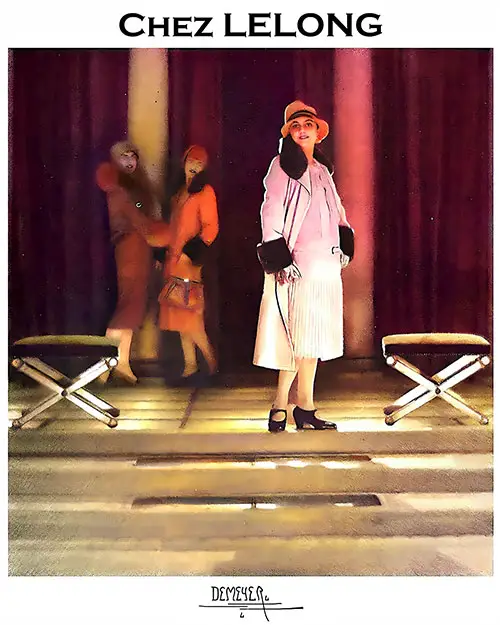
Chez Lelong. Photo par Baron De Meyer. (Harper's Bazar, October 1927) | GGA Image ID # 22700de252
Chez Lelong (October 1927)
Lelong shows the most satisfying and distinguished collection he has so far produced. Masterly in conception, it is homogeneous and stunning. It typifies simplicity in all its phases: complex simplicity, intricate simplicity, and imaginative simplicity, a relief from uninspired banality masquerading as modern plainness.
Eye-stunning styles at Lelong's belong to the past. Embroideries seem more discreet and refined; they are used sparingly and always with unerring taste and much tact. Asymmetry-harmonious asymmetry is the predominant note of this inspired collection, and color harmonies, so far supposed to clash, are used extensively.
Lelong calls these " dissonant harmonies" and uses them mostly for afternoon ensembles. A distinct trend toward an afternoon atmosphere in dress is very noticeable. Skirts are neither full nor tight, neither too short nor too long; anything too long looks prehistoric, while too much abbreviation is easily vulgar.
Lelong's collection introduces a luminous midnight blue, new shades of green, and a new color called " L. L. Blue." These innovative color choices, neither Nattier nor peacock but reminiscent of both, add a surprising twist to the collection, sparking intrigue and excitement.
Sports attire is, as usual, featured. The principal novelty is a series of ensembles consisting of plain skirts, tricot sweaters with geometric patterns, and cardigan jackets in harmonizing shades. Day dresses show little blousing.
Gowns fit snugger than before and hang straight from the shoulders. " Poppee," a lovely bright blue velvet afternoon gown, is an excellent example of this type.
One of the most striking features of this season's collections is the variety of novel velvets at Lelong's. They are almost everywhere, both plain and figured, some so sheer that they are almost transparent. This diverse use of velvets is sure to fascinate and pique the curiosity of fashion enthusiasts.
Most evening wraps at Lelong's are plain velvet, with ample mantles and deep, very full flounces reaching to the hip. Many are trimmed with fur.
The collection of distinguished-looking evening gowns at Lelong's is awe-inspiring. The dead black dresses, perfect in style, are particularly captivating. For instance, the black model called "Caresse," with layers of fan-like plaits snugly encircling the figure, exudes an exquisite elegance.
Another, "Complice," is black velvet combined with a silver and black striped wrap, and yet another is a splendid ensemble consisting of glittering black velvet, ermine, and silver.
"Emancipate" is a wonderful "L. L. Blue" velvet gown with two very large wings embroidered in blue diamonds spread over the skirt and bodice.
These are some of Lelong's most sumptuous achievements. In his quest for simplicity, he seems to have reached perfection this season.
Bibliography
Emilie Frances Bauer, “With Screen Favorites," in Dresses Magazine: Official Organ of the Associated Dress Industries of America, New York, Vol IV, No. 3, March 1921: 22-23.
"Lelong" in the Garment Manufacturers' Index, New York: The Allen-Nugent Co. Publishers, Vol. II, No. 3, October 1920: 31.
"Interesting Lucien Lelong Collection," in The American Cloak and Suit Review, New York: John M. O'Connor & Company, Vol. XXIII, No. 3, March 1922: 126.
"Designed for the Typical American Woman Exclusive Sketches From Lucien Lelong," in The American Cloak and Suit Review, New York: John M. O'Connor & Company, Vol. XXIV, No. 1, July 1922:132.
Baron de Meyer and Marjorie Howard, "What Is New in Paris: The Autumn Collections of The Great Paris Houses: Chez Lelong," in Harper's Bazar, New York: International Magazine Company, Inc., Year 61, No. 2580, October 1927: The Paris Openings Number, Illustrated By Baron de Meyer, Bernard B. Demonvel, Mary Mackinnon, Reynaldo Luza, and Dynevor Rhys, p. 81.
Paul H. Nystrom, PhD, "Chapter XI: The Paris Creators of Apparel Style - Lucien Lelong," in Economics of Fashion, New York: The Ronald Press Company, 1928, pp. 217-220.
"Paris Creators of Apparel Style: Lucien Lelong," in Economics of Fashion, New York: The Ronald Press Company, 1928, pp. 217-220.
Bayon de Meyer, "The Flower of the Mode: Lucien Lelong," in Harper's Bazar, New York: International Magazine Company, Inc., Year 63, No. 2592, The Paris Openings Number, October 1928, p. 73.
Daphne Carr, "The Sizing Question," in Dresses: Official Organ Associated Dress Industries of America, New York:Associated Dress Industries of America, Vol XIV, No. 6, June 1926, p. 10
🔥 Most Engaging Content
Here are standout features that make this article both fascinating and valuable:
Lucien Lelong’s “Kinetic Silhouette” Philosophy: His idea that clothes should enhance the body in motion (not constrain it) foreshadows the functionalism of postwar fashion and even today’s activewear 🕺🏽.
Hollywood Meets Haute Couture: The inclusion of Lillian and Dorothy Gish, Norma Talmadge, and Gilda Gray wearing Lelong garments gives this piece crossover appeal for cinema historians 🎬 and costume designers 🎭.
His Mid-Season Collection Essays: Lelong himself outlines his design logic—a rare primary source that blends art, commerce, and cultural commentary in one cohesive voice 💬🧠.
His Scientific Approach to Couture: Lelong introduced modern management techniques (like time-motion studies) and created theatrical lighting for model presentations—a game-changer in fashion merchandising 💡✨.
Export-Friendly Designs: Lelong tailored looks for the American market while staying true to Parisian artistry—this intersection is key to understanding early global fashion commerce 🌐🇫🇷🇺🇸.
📸 Noteworthy Images
Visual highlights that enrich the article:
“Lucien Lelong's idea of a flared silhouette” – A charming apron tunic that shows Lelong’s eye for structure and movement 💃.
“Norma Talmadge in a rose velvet gown” – A dramatic, Hollywood-worthy design showing luxurious French textiles and 1920s aesthetics 🌹🎞️.
“Gilda Gray in Evening Gown” – Her image adds visual drama and celebrity glamour, perfect for students studying fashion in silent-era film 🌟.
“Afternoon Coat of Grey Tiflis with Grey Fox” – Highlights Lelong’s love of muted palettes paired with luxe details 🐺🎩.
“Blue Satin and Lynx Coat” – Showcases 1928’s “attenuated lines” and the period’s emphasis on slim silhouettes.
📚 Glossary of Fashion Terms
Basque: A bodice that extends over the hips, often forming part of a peplum style.
Ceinture: French for “belt” or “sash.”
Ciré: Fabric treated to have a glossy, wet-look finish.
Cloisonné: Decorative metalwork with enamel used here as a color scheme inspiration.
Faille: A slightly ribbed, soft, lustrous fabric often made from silk or rayon.
Foulard: A lightweight, silky fabric often printed with small patterns.
Jet: A type of black gemstone or glass often used in embellishments and jewelry.
Kimono Sleeve: A wide, straight sleeve that is cut in one piece with the garment body.
Panne Velvet: A crushed velvet with a high luster and soft drape.
Serge: A sturdy, twilled fabric often used in tailored suits.
📚 Ideal for:
Fashion students analyzing 1920s silhouettes and textile evolution
History teachers crafting lessons on Parisian culture, women’s roles, or WWI/WWII-era fashion
Genealogists researching luxury retail and style among emigrants or the elite
Film studies classes focused on costuming and silent film actresses
📝 Tip for Students: Use this article and its rich images and quotes as primary or secondary sources when writing essays on fashion history, luxury culture, or Parisian identity. GG Archives is a goldmine for unique topics!
